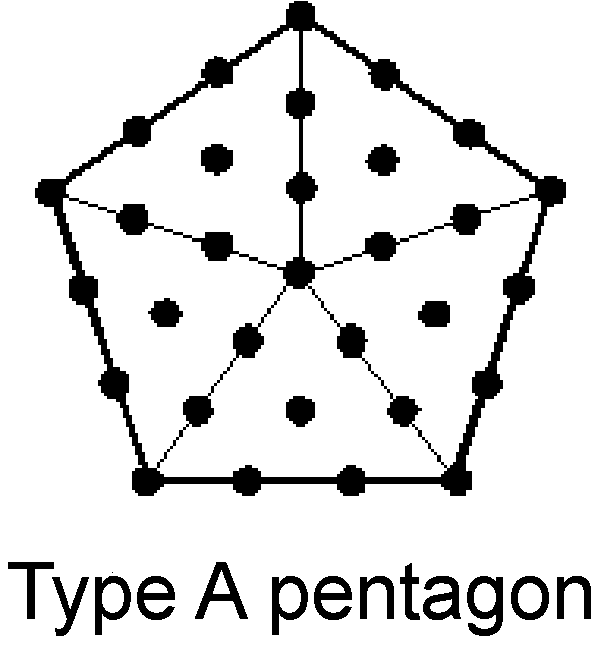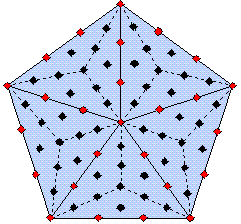


Figure 26. The Type A pentagon has 31 yods.
Figure 27. The Type B pentagon has (26+50=76) yods.
| << Previous 1... 11 12 13 14 [15] Next >> |
#15 How the pentagon embodies the number of bones in the human skeleton
A Type A pentagon has 31 yods (Fig. 26). It is a representation of EL (Hebrew: אל; English: "God"), the Godname of Chesed with number value 31. The yod at its centre A denotes the Hebrew letter aleph א (E) with gematria value 1 and the 30 yods surrounding it express the value 30 of the letter lamed ל (L). The Type B pentagon has 76 yods (Fig. 27). This is the number value of YAHWEH ELOHIM, the Godname of Tiphareth.
 |
|
 |
| Figure 26. The Type A pentagon has 31 yods. |
|
Figure 28. The Type B pentagon has 65 hexagonal yods. |
The number 26 of YAHWEH (יהוה) is the number of red yods lining the 10 sides of the five sectors of the pentagon; the number 50 of ELOHIM (אלהים) is the number of black yods inside these sectors. As there are 13 hexagonal yods per sector, the number value 65 of ADONAI (אדני), the Godname of Malkuth, is the number of hexagonal yods in the Type B pentagon (Fig. 28).
The Type C pentagon has 211 yods,* that is, 210 (=21×10) yods surround its centre. 21 is the number value of EHYEH, the Godname of Kether. It contains 206 yods other than its five defining corners (Fig. 29). In other words, given a bare pentagon, 206 more yods in 45 tetractyses (comprising 21 corners and 185 hexagonal yods) are needed to transform it into a Type C pentagon. This is how the pentagon, whose diagonal width a and side b are in the proportion of the Golden Ratio: a/b = Φ = (1+√5)/2 = 1.618..., embodies the number (206) of bones in the adult human skeleton. Many artists through the centuries have believed that this famous ratio determines the relative proportions of parts of the ideal human body. Whatever the truth of this controversial claim, here is
|
The 16th-century philosopher Heinrich Agrippa drew a man over a
pentagram inside a circle, implying a
relationship to the Golden Ratio Φ. |
|
There are 206 yods in the Type C pentagon other than its five corners touched by the head and extremities of the limbs of a human figure. They correspond to the 206 bones of the adult human skeleton. |
Figure 29
an exact, indisputable, mathematical connection between the bone composition of a normal, adult human and the Golden Proportion Φ. The 80 red yods either on sides of sectors of the pentagon in Fig. 29, at centres of its tetractyses or at their corners (except for the centre of each sector) denote the 80 bones of the axial skeleton. The remaining 126 black yods denote the 126 bones of the appendicular skeleton. Article 32 & Article 33 explain how the outer & inner Trees of Life embody the human axial and appendicular skeletons (see also Human skeleton). Article 36 shows how, when constructed from tetractyses, the polygons formed by vertices of the disdyakis triacontahedron — the polyhedral form of the inner Tree of Life — embody 206 yods that symbolize the 206 bones in the human skeleton (see also here). Why should this be so? Coincidence? No. It is because the human skeleton is the Malkuth aspect of Adam Kadmon, "Heavenly Man," represented in Kabbalah by the Tree of Life (Etz Hayim, עץ חיים), whose outer, polyhedral form is the disdyakis triacontahedron (see Polyhedral Tree of Life). The human skeleton is the Malkuth aspect of this spiritual prototype, and the Godname ADONAI of this Sephirah prescribes the pentagon that embodies how many bones generate the form of the skeleton. Far from being just the number of bones in homo sapiens sapiens that resulted by chance from millions of years of random, evolutionary mutations, the number 206 is one of the parameters that characterise all holistic systems. The human body is an example of such a system that embodies the divine archetypes expressed by the Godnames.
* Proof: The Type A n-gon has (6n+1) yods (see here). Nine yods are added per sector in the Type B n-gon, so that it has (15n+1) yods. A further (9×3=27) yods are added per sector in the Type C n-gon, which has (42n+1) yods. The Type C pentagon (n=5) has 211 yods.
| << Previous 1... 11 12 13 14 [15] Next >> |